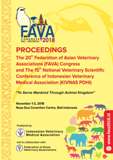IS-03 Practical Aspects of Antibiotic Stewardship in Animal Production
Abstract
Antimicrobial resistance (AMR) is emerging and is a threat for human and animal health. This increasing resistance results into treatment failures and increased mortality in humans and animals. If there is no action to reduce antimicrobial use (AMU), it is forecasted that the number of people dying due to AMR will increase considerably in the near future. AMU in animals poses a potential risk for public health as it contributes to the selection and spread of AMR which can disseminate to humans. Therefore, at global level WHO, FAO and OIE combined efforts in a such called One Health approach to minimize the public health impact of AMR associated with AMU in farm animals. The Global Action Plan on antimicrobial resistance (GAP) has been adopted by the World Health Assembly in 2015. This plan contains five strategic objectives. WHO urged all member states to develop a National Action Plan in line with the five objectives of the GAP, and with a One Health approach. Indonesia has submitted the National Action Plan on Antimicrobial Resistance 2017-2019 in the Library of National Action Plans of WHO.
Although it is not clear to what level AMU in animal production contributes to the AMR problem humans, there is a worldwide urge to reduce AMU in animal production to a minimum to protect human health. The basis of this so-called ‘antimicrobial stewardship’ is focusing on (preventive) measures which enable animals to remain healthy and thus take away the need for antimicrobial treatment. Another pillar of stewardship is limiting and strictly regulating the use of so-called ‘’critically important antimicrobials for human medicine’’, like fluoroquinolones. It can be difficult to change AMU practices which have become habits for farmers and veterinarians; therefore specific triggers are required. In the Netherlands the total therapeutic AMU (in mass sold) in farm animals doubled between 1990 and 2007; parallel to the EU-ban of antimicrobial growth promotors which were completely phased out by 2006. From 2005 onwards, several events triggered a series of measures and initiatives to reduce AMU in livestock with almost 70%. This reduction was followed by reduced AMR levels in livestock. Some key success factors were: clear reduction targets defined by the government, having full transparency on antimicrobial prescription and usage, the existence of a surveillance system for AMR, and a close collaboration of all stakeholders and a shared goal. Although specific contexts differ between countries and production systems, tailored approaches taking into account specific contexts and stakeholders can be effective in responsible use of antimicrobials.

